
by Jasmine | Jun 7, 2018 | Yoga Therapy
Time to talk triggers! Oh, the dreaded “t” word. At some point in our lives we will all have them, no one is immune. Even Oprah has them – so you’re in good company.
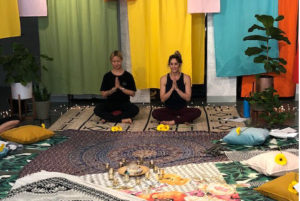
Setting an intention with Mel Mah to get clear about our triggers.
But what is a trigger? A trigger is an external event, situation, person or activity that sparks an emotional or physical reaction within us. Something happens and a wound, memory or experience re-opens and in that raw and exposed moment you feel A LOT. Often times we connect triggers to feeling of discomfort or dis-ease. But the truth is, there are just as many triggers that bring us a sense of joy, ease, safety and comfort as there are one that make us feel anxious or all “hot and bothered”.
Because I get a lot of asks around how to better manage aggravating triggers (as I like to call them), I will focus this blog on how we can explore these a little deeper.
Aggravating triggers are ones that can do just that— aggravate. This can show up in pain, sadness, increased stress, frustration and my big one, anxiety. And it’s not just the symptom or feeling that can throw off our day or week, but our response to to the trigger can greatly effect our life.
For example, have you ever gotten into a confrontation with a co-worker, friend, loved one, or even stranger on the road because you were triggered? Do you remember how that effected your day? Boy, I know I have and it’s always ended with me feeling unmotivated, fatigue, and unhappy. Some reactions can even send you down a spiral of doubt, fear, loss, you name it.
And to add fuel to the fire, some of the most common aggravating triggers related to stress, pain, and anxiety are ones we cannot avoid:
- Work – Commuting to work (traffic!!), being at work (sitting…ugh), and having deadlines at work have the potential to trigger our worries, increase our stress and create lots of tension.
- Family – Being around specific family members can make us feel more stressed, frustrated and annoyed than usual.
- Life changes – A change is just experiencing something new, but the uncertainty and lack of routine can make us panic even if it’s something we wanted (like having a baby).
- Social media – I’m throwing this one in because it’s given me some serious anxiety lately! Scrolling through “the ‘gram” and seeing everyone living their best life can trigger all sorts of comparisons, fear of missing out, lack of confidence, you name it.
At the core, a trigger is a habit. There is cause – your mom calls, your boss sends a rude email, you’re stuck in traffic – and at some point you learned or trained yourself over time to react to that fear – you panic, you get defensive, you scream, you shut down. Your reaction was initially part of your neurological “flight or fight” response to keep you safe, but is now a pattern (a likely old pattern) you are used to doing as a way to survive and protect yourself.
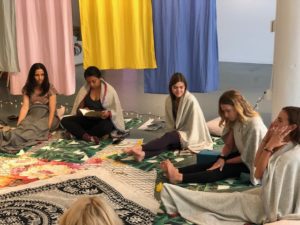
Workshop attendees getting deep into what’s underneath their triggers.
We all have triggers because life is filled with ups and downs and eventually we all experience some sort of trauma or challenge. That could be the emotional trauma of losing a loved one, being bullied, witnessing your parents fight or any time you have been made to feel that you’re not enough.
The good news is that since triggers are habits learned over time, we can unlearn them too! The bad news is that they are some of the hardest habits to break because many are embedded in how we see the world and ourselves.
Let’s look at an example. One of my biggest aggravating triggers is having a messy house, which triggers feelings of panic, anxiety, and a loss of control. It dates back to growing up in a chaotic house with lots of noise and fighting. So whenever my home is messy – looks chaotic and even feels chaotic – I’m taken back to that feeling of being a little girl who doesn’t feel safe and that makes the grown woman version of me feel unsafe too.
You might be thinking, “of course a messy home elicits some sort of reaction.” But I’m pretty sure that around the world, millions of people have messy homes and don’t launch into a state of panic and extreme unease. Now what’s interesting about this trigger, is that it’s very specific to my home. I don’t feel panicked when my friend’s home is messy or a department store is messy.
Over the years I’ve done a lot of work on this one, so I am definitely more forgiving when things aren’t “perfect” and because I share a home with someone else (my husband), I try hard to not nit pick and get overworked (stay tuned for another blog on working through your triggers). But the first step to even working through those unresolved feelings is to “notice” what your triggers are. This requires a little mindfulness and a lot of curiosity.
Here are 3 easy and eye-opening steps to get you started: Stop, Breathe, Feel. Disclaimer: You likely have dozens of aggravating triggers, but let’s just focus on spotting one.
1. Stop and observe the external: The very next time you feel the pit in your stomach, worried feelings, racing heart, achey back – stop and pay attention. You don’t have to do this immediately, but within the day take stock of your external circumstances. Perhaps, there was an external event that happened right before your feelings began.
What are you doing? Who are you with? What’s going on around you? Notice all of the details of your environment, your trigger is lurking in one of those areas. If you were talking to someone, what did they say to you? Get out a piece of paper or your phone and write down the details for later.
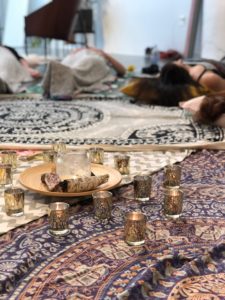
Meditation helps you practice breathing and uncover the layers of feelings.
2. Breathe to capture the moment: Very important step. You need to breathe so you can slow yourself down and get curious about the event. If you have a meditation practice, use that to meditate for at least 5 minutes. If not, try a 5-4-5 breath to help you focus – Inhale for 5 counts, hold for 4 counts, and exhale for 5 counts. Repeat this at least 3X to ensure you are clear enough to proceed to the next step.
3. Feel what’s going on internally: What exactly are you feeling? Yes, bothered of course, but what specifically? Are you feeling bad about a conversation that didn’t go as expected and now you’re worried that you’ll get in trouble at work? Get curious and detailed about each feeling and micro-feeling that is going on at that moment and the story you’re telling yourself about those feelings. Once you’ve figured this out, map back to the items from Step #1 and start making the connection.
Give this exercise a try a few times and see what you learn about yourself and what’s triggering you. Remember, when noticing triggers it’s important to observe and remain curious about both those that aggravate and those that bring ease. This type of mindful observation can lead to some really clear answers around who we are and also invite in a deeper sense of self-acceptance and self-compassion. Comment and let us know what you discover!
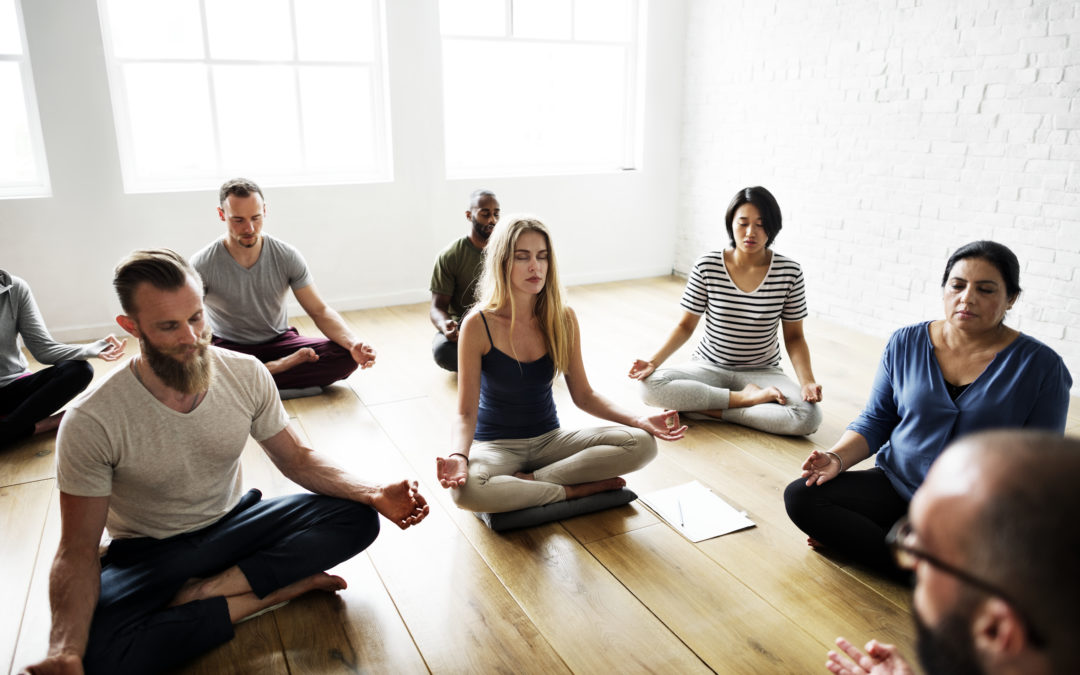
by Jasmine | May 25, 2018 | Yoga, Yoga Lifestyle, Yoga Therapy, Yoga World
Do you remember the very first time you did yoga? If you’re like me, it was in a group class that my friend “swore by.” It was in these group yoga classes that we learned the basics of yoga: our first downward dog, chair pose, nostril breathing and the bliss of our very first savasana.

Group classes are awesome for yogis of all levels and intentions and most teachers provide a general teaching style to address the ranges of needs.
Unlike group classes, yoga therapy puts the individual at the center and it’s all about the person’s specific need to heal the mind, body and spirit. Each session is private (or at most a small focused group of 3-4 people) and targeted to address a goal like reducing stress, managing anxiety, breathing better or easing chronic pain.
As a Yoga Therapist, some of my clients have practiced yoga for years, yet are only able to heal their anxiety, depression, stress or back pain (to name a few), through our one-on-one work.
But what if you’re ready for a more healing yoga practice but not quite ready to see a Yoga Therapist? Have no fear, there are a few ways you can turn up the healing in a large group setting. Check our list of simple ways to approach your next group class for a more therapeutic and personalized experience.
Before the class
- Decide what needs attention: Before the class starts, I always encourage my clients and students to take a mental inventory. Notice what’s showing up for you (sensations, emotions, energy, etc). What’s been bothering you or what would you like to explore? Take a few minutes to check in with yourself and observe what feels tight or contentious. Also, take notice of what feels good and at ease. Maybe you’re having shoulder pain or work has been extra stressful. Maybe your feeling a sense of relief or your feet feel relaxed. Then, based on your self discoveries, set an intention to support whatever it is you are needing that week, day or in that moment.
- Commit: Whatever you picked from the above exercise, commit that as your “healing intention” for the rest of the class. For me, I’m always working on ways to manage my anxiety and often notice anxious tension in my body each time I go through my personal inventory. Because this is a reoccurring theme, this month I decided to focus on my relationship to fear and worry throughout my practice.
During the class
- Remember that healing intention: It’s pretty much guaranteed that while you’ll be “in the flow” the chit chatter of the mind will start to creep in. “Shoot, did I return that email?”, “What am I going to have for dinner tonight?” Don’t worry this is natural and you’re not alone. It’s simply your subconscious mind and its tendency to pull you away from the present moment. Lucky for you, you set your healing intention before the class so you’ll tap into this in these moments.
- Slow down your movements: Be aware of the transitions coming in and out of poses just as much as you are aware of the alignment in the pose itself. Notice what your movement patterns are and see if you can offer something different to keep things fresh and supporting your intention.
- Close your eyes: If comfortable, close your eyes as you move through a salutation or while holding a more familiar pose like Warrior II. This encourages the attention to continue to move inward and also invites in space to let go of judgment and just be with what is.
- Honor your body and your energy level: Modify poses, skip vinyasas, or drop into child’s pose at anytime. Remember, you set a healing intention and need to honor it so be patient and compassionate. Do not judge yourself for these choices! There is no “good” or “bad” in the healing process, there is just what you need.
- Keep your eyes on your mat: Remember, this class is all about you and your healing intention, so let’s keep it that way. It’s easy to get caught up in what your neighbors are doing and follow their lead. However, when we focus on mimicking someone else’s practice with lose the authenticity of our own.
After the class / in between classes
- Meditate on your healing intention – Before the class closes off, take a moment to come back to your healing intention and notice how it now feels in your body. Observe the impact your practice has had. Is the pain or fear better or worse? Has it moved? Maybe it’s the same? Are you more at ease? Whatever you’re noticing, know that this is your perfect experience.
As you move about life, explore integrating this type of reflection and awareness into your daily routine frequently reminding yourself of your intentions to heal.
Yoga is an individual practice, even when you’re surrounded by people on and off the mat. I hope these steps invite you to make your practice and little more you and allow you to dive deeper into your healing needs.
Do you have other tips for taking your practice to the next level? Share with us below!

by Jasmine | Apr 5, 2018 | Yoga Therapy
Me: “What are you doing this week?” Everyone I know: “I’m spring cleaning!” If December and January are for planting our goal setting seeds, then March and April are for cleansing and offering space for those seedlings to blossom. It’s like the natural reaction for surviving the brutal winter that was filled with cold days, the flu, and the rough road of trying to get that resolution to stick. Everyone around me is a buzz (including the bees) with cleaning out their closets, decluttering their shelves (visit our blog for ways to make your home your sanctuary) and even hitting up the Goodwill like it’s the hottest place to be.
In these spring months, we are reminded of new life, rebirth and refreshing ourselves. Spring is a time when things come into bloom, which is why it is important to cleanse our internal and external environment in the effort to offer a livable space for the new to take host. I mean, think about it, would you want to move into a new home that was unkept and had remittance of the last tenant? I know I wouldn’t. During Spring, it is essential to recognize that there is time for gratitude (lessons learned, experiences had) but also for letting go.
In yoga, this time of year reminds us that our physical surroundings aren’t the only things that need to be cleansed. Our insides, our minds, bodies, and energetic spirit are also due for a refresh.
Cleansing the Mind: Notice Patterns
This is where I always start. Our thoughts are a powerful tool and can literally change the environment of our bodies, meaning they can change the way our cells respond and grow. They are at the center of everything we know and experience. Thoughts create our perceptions or (more often than not) our misperceptions. So, starting here for your cleanse will pack the biggest punch. I like to think of the mind as the captain, the body as the ship and your physical space as the waters of the ocean.
Cleansing the mind is all about working to free yourself from non-serving thoughts and self-judgments. I take this time to identify those old patterns of thinking that are keeping me down and limiting my growth. We (on average) have ~50,000 thoughts on a daily basis, 90% are repetitive and 80% of those are negative. In short, that’s a lot of negative and repetitive thinking! The steps of thought cleansing may take a little more time than deciding which sweater to keep, but believe me it’s worth it.

Put pen to paper and observe thoughts from a different perspective.
As we practice mindfulness, we can watch our thoughts with non judgmental attention and notice which ones are negative and/or repetitive and cleanse those thoughts to make powerful changes to our subconscious patterns.
- Step 1: Grab a piece of paper or a journal. Set a timer for 3 minutes and write all of your thoughts down. Just pay attention to what you’re thinking and get them out on paper stream of consciousness style.
- Step 2: Notice the patterns. What are the thoughts coming up again and again. Since I’ve been trying to become more vulnerable, my ugly sweater version of a thought has been that “people only trust perfection.”
- Step 3: Spot which ones are negative and not true – circle them.
- Step 4: Scratch out the ones that are not serving you. All you are left with are the positive thoughts and possibilities.
As we cross out the negative thought patterns, you are cleansing and making space for a new thought pattern to take host in that mental space. And since our thoughts are so powerful, the more we can get cleaner more serving thoughts, the more our bodies and environments will bloom in and manifest in the life of our dreams. Check out our last post on the rule of little and often to gain more tips on how to make this practice truly stick!
Cleansing the Body: Breathe it, Twist it
Now that we have our minds ready, we’ll move onto the body that is the ship. This is the vessel in which we navigate the world and is critical to also tidy up to feel centered and balanced. There are many things we can do to detox in this area, from diet, exercise, massages, facials, etc. One less common way (yet effective) is by finding ways to stimulate heat.
Heat, or fire, is the element that cleanses and burns away unwanted energy. It lives in your belly with nearly all our vital organs. When we stimulate that heat and cleanse from the belly, we can stimulate more passion and more motivation. Breath and twists are great cleaners for the body. Let’s see why.

Try this single leg twist before getting up to stimulate digestion and improve circulation.
What breath builds heat?
Ujjayi breathing, also known as “victorious breath” has become the signature breath practice in most vinyasa flow classes. Why? Because the breath technique challenges your respiratory muscles and encourages you to focus your attention which results in a quick yet gentle build of internal heat. I’ll admit, it takes a few tries to nail this one down, but it does add a wonderful heating element to your movement practice.
Begin in a comfortable seated position. Take a few gentle breaths in and out through the nose to neutralize your natural breath pattern.
Step 1
- To start moving into Ujayii breathing, inhale through your nose.
- As you exhale, open your mouth and make the “HA” sound (like you’re fogging up a window). Notice the breath graze the throat on the exhale.
- Repeat 3x.
Step 2
- Soften the lips to close.
- Inhale through the nose and exhale through the nose, but this time maintain the same constriction in the throat created by the “HA” sound as when your mouth was open.
- You will continue to hear an ocean-like sound as you breath in and out through the nose.
Why twist?
Yoga twists are detoxifiers because they directly impact our vital organs. When we twist, we detoxify anything that is stuck in that space. Think of the shape your belly creates – it’s like ringing out a sponge. This idea comes from B.K.S. Iyengar’s “squeeze and soak” theory. The motion of twisting the spine squeezes the muscles, spinal disks, and abdominal organs. When you release, we push out old blood and make space for new blood to flood in and nourish the organs and aid digestion.
In twists, we are not only finding spinal rotation but we are also creating spinal length in between the bones. This newly created space can stimulate life and release stagnant energy.
Cleansing your Space: Grab your essential oils
Okay, I know I promised a mind-body blog only but I had to bring in a little shout-out to our physical spaces. Essential oils can be like little pockets of positivity to move towards optimism. So if you’re still dead-set on cleaning house this spring, consider including essential oils into the mix.
Oils enhance positivity because they can shift our moods. Diffusing oils creates a sense of balance, harmony and a more uplifting atmosphere at work or at home. When you smell an oil you instantly feel more uplifted and energized because of their many healing properties.
My favorite oils for spring cleaning are Grapefruit, Basil, Frankincense (an ancient and powerful purifier), Rosemary and Lemon.
Need a recipe for a custom spring cleansing oil blend? Here’s one of my go to’s!

Create your own custom blend that invites positivity and growth.
In a separate dropper bottle add:
- 10 drops of Grapefruit
- 8 drops of Lemon
- 4 drops of Frankincense
- 4 drops of Basil
Store in a cool dry place and use throughout the spring season to nurture positivity and growth.
So, as you get rid of those worn down heels and pilly sweaters, we hope you use some of these tips to also invite spring into your mind, body and space.
How are you preparing for the spring? Share in the comments for a chance to win a custom spring essential oils blend!
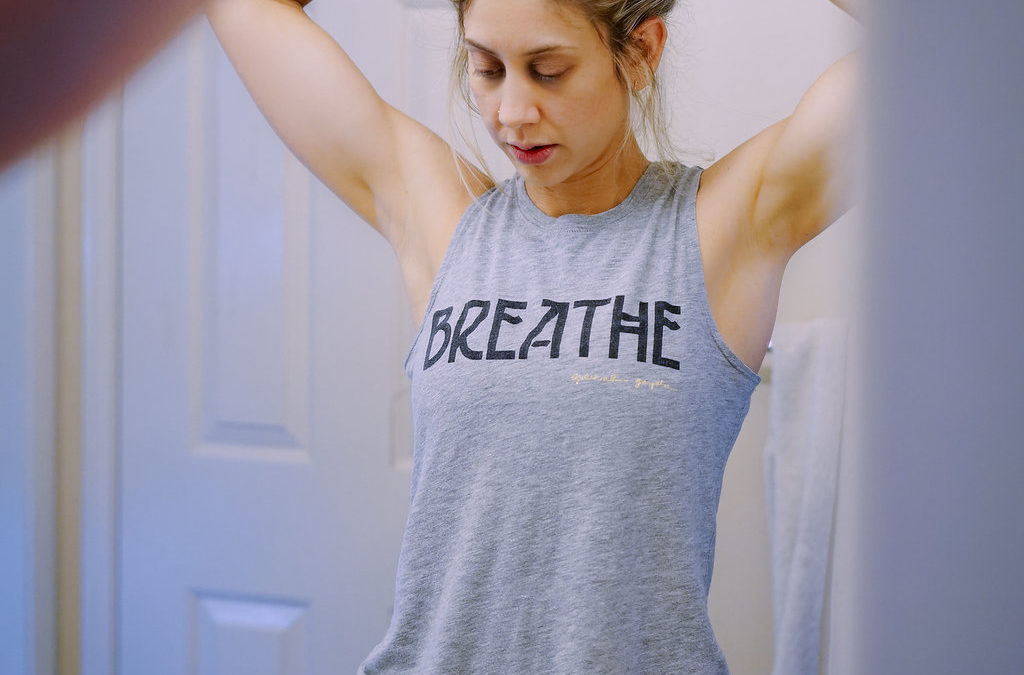
by Jasmine | Mar 22, 2018 | Yoga Therapy
I used to think people only trusted perfection so I shied away from getting too personal on my blog and in real life. I know, I know, what’s the point of having a blog if you’re not going to share your personal stories? I was stuck in the habit of fear that sharing my flaws and demons would discredit me. I knew that I needed to be more vulnerable but I also knew that sharing some of my messy truth might make me recoil into my shell.
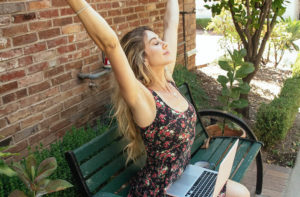
Making the choice to gradually stop fearing the truth and pain of my own journey.
Instead of going full throttle and posting my entire life story on Instagram, which would feel like a chore, I started small but consistently.
- I first opened up within short Instagram captions. It was a small but safe step since I figured people wouldn’t read the entire thing.
- I then added some personal details on a blog, revealing that I had shingles. My little fingers were shaking as I wrote that but I put it out there into the world.
- Then I began to open up to live crowds like at our “Treat yo’self” event. I shared about my last relationship, struggles with co-dependency and ugly breakup. It was only a short 3-minute story but still a little but critical step to practicing vulnerability. After I spoke, several people thanked me for being so authentic and vulnerable.
I’m gradually integrating this new more vulnerable me into my story by following the rule of little and often. I use this mantra a lot with my clients who are trying to decrease stress, practice mindfulness or change any type of habit.
What is the rule of little and often?
The rule of little and often is about integration and how to develop consistency to gently change our habits. This comes from Jon Kabot Zinn (“the father of mindfulness”). It’s the one sure-fire way to implement change because the more often we do something, the more we’ll integrate that thing into our life and sustainably shift our patterns.
If we’re used to doing something the same way every day, then the only way to shift that behavior is to start doing something small just as often. This will allow the change to feel more like a choice and less like a chore.

At the Bumble Hive LA, opening up in public about my past for the first time. Just a little at a time.
This is similar to the idea of crowding-out, a go-to nutritionist strategy. The premise is simple: Don’t focus on what NOT to do because that can become overwhelming and invoke a “funk-like” state. Think about the last time you tried to drastically change your eating habits over night. “Hangriness” set in immediately and you became grumpy, annoyed and ready to give up, which is what a lot of people end up doing.
A more gentle way is to focus on what you need to ADD in and then gradually crowd out those items or behaviors that are no longer serving you. For example, if you’re goal is to decrease stress, don’t dive straight into an hour long meditation practice or quit your hectic job Jerry Maguire-style. While both are tempting, you might end up frustrated, full of regret and in a funk.
Instead, I recommend that my clients start adding a 2-minute meditation 3 times a week and then see how that feels. Quitting your stressful job may be the right choice eventually, but until you’ve gradually shifted your patterns you won’t know if it was the job or something else that was contributing to your stress.
Little and often, not big and all at once. This can be applied to anything if you follow these simple steps.
1. Notice your Symptoms
How do you start discovering that you need to take a breath or that you’re even in a stressed or sub-optimal state than the one you’d like to be in? Most of the time we don’t even notice that we’re in need of any mindfulness because we are so used to constantly being stressed and no longer view our chronic symptoms as symptoms at all! We basically adapt to that state and stop asking “could I feel differently.”
Little and often asks that once a day you just start paying attention to some of the common symptoms of the habit you want to change. In the case of stress, that could be:
- shortness of breath
- headaches
- neck pain
- drowsiness
- irritability
It’s hard for us to recognize that we’re in a stressed state, but we can definitely recognize when we have a headache or any other types of physical discomfort. And that can be your trigger for taking care of yourself.
2. Connect with your why
You’ll then want to find out why. Find out why you want to reduce your stress levels, this will help you implement the little and often rule. A few common ones for stress are that your health is at risk, you’re struggling at work, or your relationships are suffering. Get really clear with what’s motivating you and why the change is truly needed. This will be your intention that you can tap into to keep you consistent.
Brene Brown talks a lot about this in “Rising Strong”. Identify what you are feeling – that’s the trigger – and then get curious about why you are feeling it. Where does this feeling come from and why do you want to change it?

Checking in with my why to keep me focused on the results.
In the example of my quest for vulnerability, I felt scared each time I thought about telling my story about my Ex-partner. I was scared about revisiting the disappointment of the break-up and even more frightened about what people would think if they knew I had sacrificed my own self-care. The “why”/motivation to change was to more publicly heal from that shame and also show-up more openly for clients and loved-ones.
Knowing your why and being super clear on what’s underneath your desire for a habit change will help you take those little and often steps to healing and habit change.
3. Progressive integration
Now you actually have to do something differently, but again it’s just a little bit of different on a consistent basis. Start by first finding those times in the day where it makes sense to incorporate your new pattern. The best time to practice a new habit is during those little “dead spaces” when you’re usually browsing online or Insta-scrolling through your phone. Do you spend a lot of time sitting in traffic, in between meetings or waiting to shuttle your kids to different activities? You’ll want to capitalize on those moments to try out your new habit.
In the case of reducing stress, use the moments in traffic to practice new breathing techniques. Take a few minutes to notice your breath and the try slowing it down just for a few minutes. This is such a small exercise, but if you do it each time you’re in traffic – which for me is all the time – those moments start adding up.
The same goes for adding more plants and vegetables to your diet. No need to go full-on vegan tomorrow. Instead use your next snack break or time waiting for your Uber to eat a piece of fruit or something with zero animal products.

Getting honest with myself during my in between moments helps me practice my new habit.
For my vulnerability habit, I use my time in traffic to practice sharing my story to myself. I’ll literally talk to myself and say out loud the things I’m most afraid of. I also journal to get my fears out on the page in between virtual coaching sessions with clients.
As you take advantage of these little moments, you’ll start noticing that you’re spending less time on the behavior you were trying to move away from. It’s the consistent implementation that makes you more aware, see results and shift your patterns.
This is where we move from chore to choice. That’s a shift in perspective so that you are choosing to focus on your self-care instead of getting in the funk of feeling like you’ve included another chore to your growing list.
When we’ve been doing something or thinking something for 10 – 20 years, like me and my fear of vulnerability, it will take a lot of constant gentle shifts in the opposite directions to make these new changes stick. You don’t have to undo everything – no all at once life overhauls here. It’s all about the moment, taking advantage of it to incorporate a small new shift and then being grateful that you did.
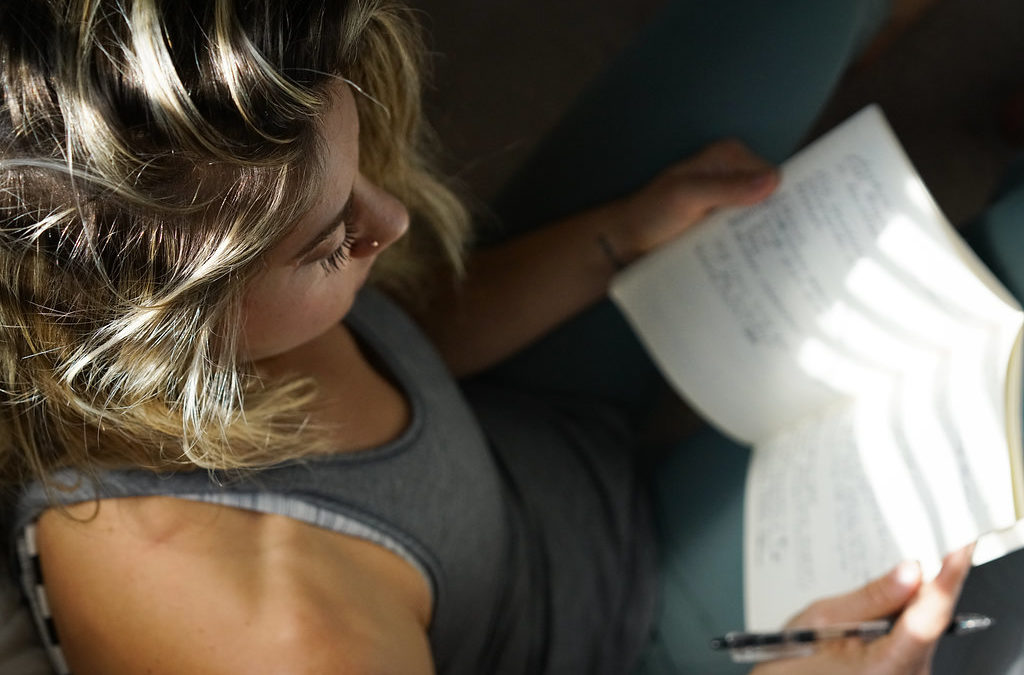
by Jasmine | Mar 9, 2018 | Yoga Therapy
In honor of International Women’s Day, we’ve invited three strong and vibrant women to share their thoughts on one of our go-to mindfulness quotes this year from @Beautyesque: “Everything is a catalyst for growth and evolution if you choose to go deep and see the lessons, triggers and blessings at the same loving frequency.” Do you have a go-to quote that inspires you and keeps you warm at night? Send it our way and get featured!
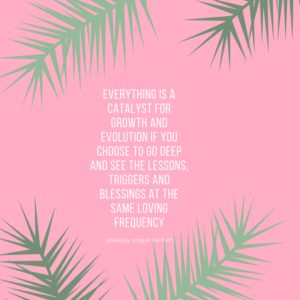
It’s almost springtime which means all of the stuff that’s been underground and trapped near the root is finally coming to bloom. The growth of the flower that has been slowly brewing beneath the surface is poking its head out and ready to say hello to the world. For the rest of us, growth is a bit more complicated and doesn’t always look as pretty as a bud or dewy leaf. Sometimes growth is ugly and scary and actually feels a lot like suffering … ugh!
But this year, my intention is to see the growth possible in every situations including the wonderful and brutal lessons that I learn the hard way like getting so burned out that I get Shingles, oversleep and miss one of my teaching gigs. Or like when I did some great networking – really clicking with fellow-yogi gals – at an event but then they never responded to my follow-up emails. Am I not cool or something? But there is growth there! And it’s not about me “taking a hint” that I might not be cool – I’ll make up my own mind about that. It’s about me saying, “why does it bother me that they didn’t respond, what am I attaching to that and how can let go of that old pattern of thinking that their non-response is a verdict on my life.” And why the hell am I not focusing on the four other people who did respond back? These are the things I can make choices about.
I am choosing to see the underlying triggers and patterns (overdoing it, assigning value to how others react to me) waiting to be broken and loving them just as I love the hugs from my client after a break-through session. It’s my choice and I hope you join me and choose it too. See why these ladies agree.
1. Melitta Johnson (Yoga Instructor, Mental Health Wellness Advocate and Mother): “Everything is a catalyst for growth and evolution.” That’s deep and it’s true if you are open to the experiences that life offers. Today, I live life without regret, using every experience as an opportunity for growth. However, there was a time in my life where I felt like I didn’t have much control over the things that occurred, which made me feel vulnerable about what was to come in the future and the blessings that would manifest as a result of the lessons. I was closed off to new experiences due to fear. People died. Dreams chattered. Life withered away.
But then the season changed. The storm passed, it seemed. I began to see the light. Purpose came from the people that died and the dreams that shattered. Life didn’t wither away. Life marched on better than ever, but not because things were on the up and up, but because I chose to take life’s experience with me and pack them in my toolbox to create the blessings of love, kindness and happiness for myself and for others. I’m heading into the unknown future with all of these lessons and a full toolbox that will just keep getting bigger. That’s Evolution.
When I made the conscious decision to recommit my life to yoga, I didn’t fully understand what that commitment meant. In the past, I’d start practicing and then I’d stop practicing for various reasons. This time around around, I began my practice and kept going, full steam ahead. I practice daily, but my daily practice isn’t always 1-2 hours long. It varies. At times I practice for 2 hours and other times I practice for 10 minutes. The key is daily mindful movement … daily growth.
About a year ago, I started to capture my yoga back and share via social media. Every time I look back at a photo, it’s so amazing to see the subtle ways I’ve grown without even being aware. I recently looked back at a photo from January 2017 while I was in Ardha Navasana (half-boat pose) and I remember thinking about how much I struggled to lift my legs and smile as my abs were shaking profusely. I remember trying desperately to straighten my knees, but it didn’t happen that day and how it felt like a defeat.
Fast forward a year to January 2018, I sat gently on the 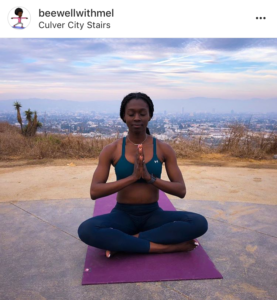 moist grass, slowly raised my feet into the air (with bent knees first) and then straightened my knees – I did it! Navasana! This “win” didn’t occur overnight but bit-by-bit with steady moments of growth. It is my daily dedicated yoga practice – sometimes easy, sometimes hard – that made the difference. While there is still much room for improvement, I will celebrate progress and evolution as it occurs and find the treasures in the shaking abs, bent knees and everything in between.
moist grass, slowly raised my feet into the air (with bent knees first) and then straightened my knees – I did it! Navasana! This “win” didn’t occur overnight but bit-by-bit with steady moments of growth. It is my daily dedicated yoga practice – sometimes easy, sometimes hard – that made the difference. While there is still much room for improvement, I will celebrate progress and evolution as it occurs and find the treasures in the shaking abs, bent knees and everything in between.
Melitta Johnson is a RYS-200 Yoga Instructor, Wellness Advocate and Founder of the Elgin Foundation for Mental Health Wellness. She lives in Carson, California with her three children and husband. Follow her on Instragram @beewellwithmel or learn more about her in her ROOT Hero Story.
2. Kat McGee (Yoga Instructor, Life Coach): “Everything is a catalyst for growth and evolution.” When I read this what comes to mind immediately is the Bodhisattva Prayer – the prayer of the awakening being which says: “May everything that’s happening now serve the awakening of my heart and mind”. I appreciate the simplicity of this thought and it also directs me towards the reality that sometimes we need some support to embrace an idea like this.
Logically we can know things to be true and yet, in the heat of the human fire, it may not feel readily accessible. We may even read something like this and if we are feeling really raw think, “Yeah, well fuck you positive, pearly thought about seeing this life crushing situation from the frequency of love.” (Insert laughter because yes, that is how it can feel). This is why the Bodhisattva Prayer comes to mind; it’s a request for support when our highest awareness isn’t so readily available.
Just this past holiday between the week of Christmas and New Years, my partner and I separated and I made a major move, with literally all of my belongings, by myself on Christmas day while sleeping at a friends guest space, still working with my own clients and traveling over the holidays.
Even though I made the right decision, all of the human fears, emotions and intense levels of stress were there. And even though I felt equipped and empowered to do what I needed to do, I was still fully broken-hearted and having to honestly hold those feelings.
During that and many other challenging times, the view point of Truth was there but the frequency of unconditional love wasn’t always available, nor realistic as it often isn’t when we are mourning loss. But the gentle request of the Boddhisattva prayer: “May everything that’s happening now serve the awakening of my heart and mind”, the supportive frequency of that request that says, even though I can’t see it in this instance, I genuinely want to see and love and fully awaken; that allowed me to remain in the frequency of peace, until I was on the other side of the challenge enough to return to the frequency of love.

Kat McGee is reputed as one of the most progressive yoga teachers and coaches on the West Coast. Formally trained while living in India under the guidance of Swami Vishveketu and currently serving as a Lululemon Ambassador, she has over 1000 hours of training and is an ERYT-500 Instructor. Kat’s approach to yogic arts is physically stimulating and ultimately heart centered. Catch her at Soulspace in Malibu or follow her on Instagram @katmcgeeyoga.
3. Ariana Proehl (Practicing Yogi): Everything is a catalyst for growth and evolution. This makes me think about one of Oprah’s gems about remembering that things aren’t happening to you, but rather for you. Whether it’s a glory moment or a struggle moment.
Now I can’t honestly say that I always approach things with the same loving frequency. I can be judgmental, and I’m the worst judge against myself. I compare myself to others a lot, where they are in life vs. where I am. That turns into a lot of “shoulds”. I “should” be doing this by now. I “should” be making this much by now. And it’s easy to spiral into shaming myself for being who I am and where I am in this moment. Often it’s those really low moments where I can either just give all the way in to the ‘Little Hater’ voice in my head, or I can choose to trust and keep going.
I guess that’s what the low moments can be good for and that’s what I strive to focus on when I could just give up and wallow in the shallow (hmmm, wallow and shallow are surprisingly close in spelling). Those low moments have forced me to dig deep when maybe I didn’t want to, or didn’t think there was anything else to give or to gain or places to grow. And then I get to realize that I’m stronger than I was giving myself credit for, or way less concerned about those comparisons than my ego would have me think. And the shame gets a little less powerful, bit by bit, and it becomes easier to see that the universe isn’t conspiring against me, it’s conspiring for me.
Ariana Proehl is a media professional, producer and conversation starter. Check her out at www.arianaproehl.com. 
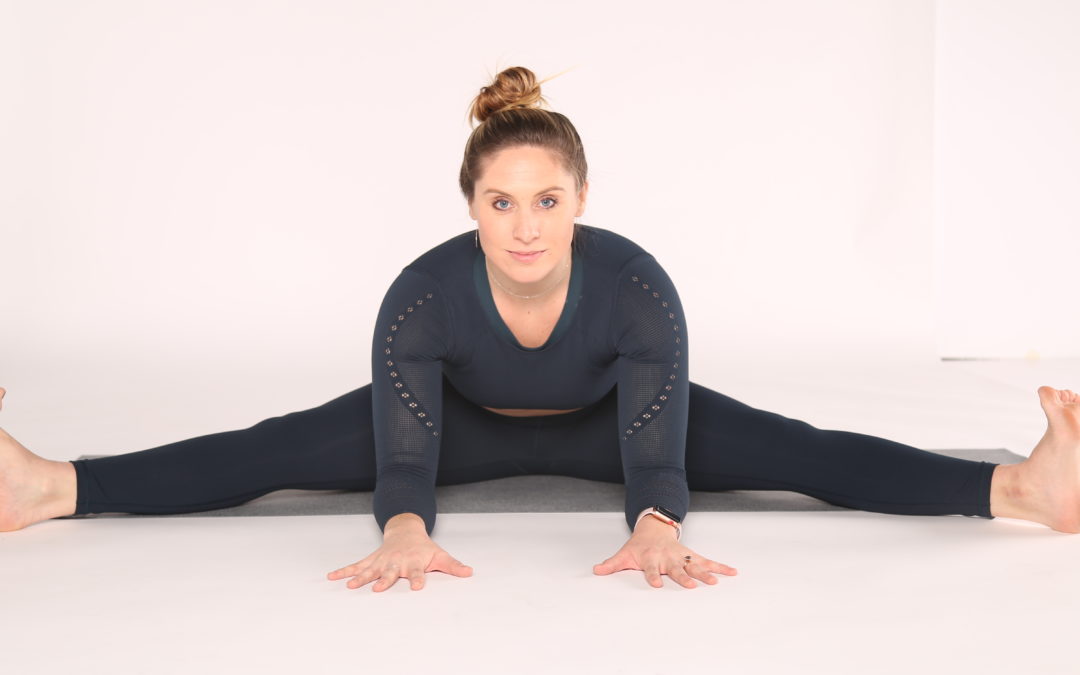
by Jasmine | Feb 23, 2018 | Yoga Therapy
Welcome a brand new guest blogger to the ROOT tribe, yoga instructor and meditation coach Kate Green! Read on to learn about how yoga has helped her discover a whole new meaning of work.
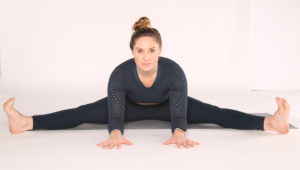
Work, work, work, work, work … On a daily basis, we all work hard. We hustle at our jobs and sometimes at our side-hustles, we take care of loved ones, and we sweat it out at the gym or on the mat. In my past, I regularly checked all of these boxes but I consistently ignored what I consider the most important work we can perform – that which is crucial to our health and happiness – internal work.
Internal work is the displacement of our regular patterns of thoughts and emotions. Now, you may be thinking, “Patterns – what patterns? Every thought I have is unique, special, and new.” Yes, you as an individual are unique and special but, if you’re like most of us, your thoughts tend to follow a repeatable pattern.This is because over time, through experiences, our minds are conditioned to react to events around us in certain ways, often against our own best interests. We consume so much information that we have to create mental shortcuts to survive. The trouble comes when those shortcuts start to limit our possibilities and keep us from growing.
This is why internal work is so crucial. The work we put into dissolving those patterns creates space within us, so that we may live more wholly in the present, experiencing the world with a more child-like and curious mind, free from judgement. And once you remove judgement then we’re really free to go after what we really want. No woman, no cry? More like no judgement, no cry because as we shed judgement of ourselves we shed our fear, hesitation and attachment to those pesky outcomes.
On the flipside, when we ignore our internal work, we overcompensate in other places. For me, it was at my job. Didn’t matter which job I had, I would measure my self-worth by how much stress I could absorb and keep going. Pushing myself further, taking less time for myself, grinning and bearing it. And guess what? I wasn’t even making good money! What the what?
My motivation was an internal displacement – searching for approval from external forces.I was always in early and staying late, taking on more than could possibly be finished within a workday. There was one year where I only took one vacation day and I was actually proud of myself for “working so hard.” I wore it like a badge of honor and thought that it said something positive about me to my boss. If I could prove to everyone that I was the hardest worker on the team, I’d be rewarded with bonuses, promotions, praise, etc. Right?
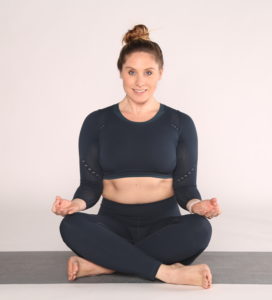 Wrong. In fact, it left me feeling disparaged, under-appreciated, and exhausted. I’d probably still be slaving away if it wasn’t for the internal transformation I’ve experienced. I’d like to take credit for my awakening, chalk it up to hours spent in silence in an ashram, but really it boils down to being just awake enough to take a few subtle (and not-so-subtle) hints.
Wrong. In fact, it left me feeling disparaged, under-appreciated, and exhausted. I’d probably still be slaving away if it wasn’t for the internal transformation I’ve experienced. I’d like to take credit for my awakening, chalk it up to hours spent in silence in an ashram, but really it boils down to being just awake enough to take a few subtle (and not-so-subtle) hints.
Namaste
I found my yoga practice at a place called Syncstudio in Brooklyn, as I think of it, an oasis of space in a crowded, manic city. I don’t mean physical space, obviously, but rather space to drop inside yourself. It was here that my ongoing transformation begun. Run by two devoted young women, Karla Misjan and Ashley Lively, the classes at Syncstudio all weave in threads of mindfulness that really sunk in for me.
The realization that I had during one of Karla’s Savasanas was very simple, really: Sutra 2.42 – By contentment, supreme joy is gained.
I’m not sure if she said it exactly like that, but the message was clear. Meet yourself where you are, in your own truth, and learn to be okay with that. The physical work that we do on the mat is a tool to help create space in our bodies that can be called upon by our minds when the challenges become internal. Practicing stillness and ease when faced with struggle. Once you allow the mind to stop whirling for a moment and peak a glimpse of the space within you, the doubt and anxiety fades and you’re left with peace.
It was here that I found my contentment – contentment that I would and could be the provider of my own happiness and light.I remember thinking, “If I was by myself for the rest of my life, I’d be okay with that.” 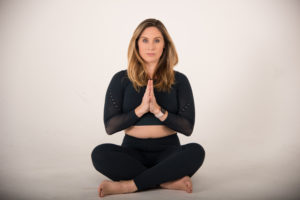
Above all I learned the most important lessons that change everything:
- Happiness wasn’t going to land in my lap one day (big let down)
- I had to be okay with myself first and foremost
- I had to take care of my own happiness
Whoopsie!
One of the more painfully obvious lessons arrived not long after moving to Los Angeles in the form a Tibia/Fibula Open Reduction and Internal Fixation. In true recurring pattern fashion, I was out to prove (to who??) I was the strongest party-gal around. Can I dance on a stool after a day of drinks? I can sure try. Lessons from my yoga practice weren’t sinking in? The universe toppled that stool right over and I immediately learned what it was like to be still… for 3 months straight.
It took two surgeries to mend my bones. And the time spent off my feet meant a lot of muscle loss. My recovery not only included physical therapy but also reignited passion for yoga (it was wonderful rehabilitation for my left side). As soon as I was able to stand, I was back in the studio. I started to find teachers I loved, focused acutely on my placement and posture, and let the internal lessons absorb. I learned to accept my current status and meet myself where I was; quite weak and lopsided. I opened up to my teachers about my injury and was met with support and encouragement, as well as wise reminders to take baby steps. It was then that I learned that yoga was a seriously valuable recovery tool.
Work Hard Play Hard
I had found it – the ultimate job for me. A job that required 12 hours days regularly, and actually had the motto “Work Hard Play Hard” worked into their branding. When I switched teams and starting working for a new boss, no matter how hard I worked, they always wanted more time. My efforts seemed fruitless and this is where the magical, yet hard to read sign is. After breaking my leg and recognizing that I was out of alignment with my internal truth, I stopped pouring my life into this job. I set boundaries and didn’t let things get to me so personally. Needless to say, my role there quickly ended.
You thought I was going to say it got better, didn’t you. As if a sign from the gods, my internal practice was starting to pay off in the physical realm, and my life didn’t align with the manic “Work Hard Play Hard” lifestyle any longer. But all is not lost, I now have a job that I love that I can devote my intellect and energy to in an authentic way. And I still certainly play hard.
In many ways I am working on being more present and whole in my daily life. I take the time to enjoy making my coffee or brushing my teeth, appreciating the ease and stillness of these moments. Living in Los Angeles, I get a lot of practice with delivering compassion to other drivers. In my new role as an analyst, my work is all about detail. When engaging with a project, I (try to) practice single-tasking, focusing my whole attention to one thing at a time, ensuring that I set myself up for success in the future. I know that when I come back to review or revisit my work, I can be assured that it was done thoughtfully, and not rushed.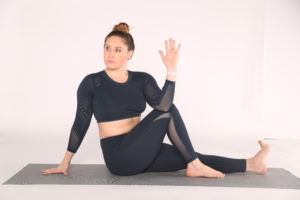
There are still certainly times when I feel the pressure of a deadline or the stress of nothing turning out the way I planned. As we learn in yoga though, true mastery does not mean changing the world around you, but rather changing the way you respond. My natural tendency is to make people happy – pulling me in generally more directions than I need to be. When I find my stress levels rising, I now take a break instead of letting things consume me. I notice when I’m getting more irritable and know that I can choose to go down a different path outside of my old habits. This allows me to show up fully for my next task or meeting, without the cloud of distraction hovering over me.
Carrying On With My Work
I feel lucky to have been able to shift my perspective in life and feel like I found my yoga practice at a time when I could have gone down a dark road forever. I believe that my yoga practice saved my life, or at least it saved my happiness. It created the tiniest bit of space within me and allowed me to absorb so many important lessons. I now recognize my patterns more easily and I notice my thoughts and fears as they pass through me like clouds passing through the sky.
To continue down this path and explore new spaces and lessons, I recently enrolled in and completed a 200hr yoga teacher training program with Yogaworks in Santa Monica. While I generally shy away from expressing myself honestly and openly, I want to share my work with others and, through creating space, pay forward the blessings that opened my eyes. And in a very full-circle moment, I led 30 of my new coworkers in a guided meditation during company-wide education day. Work used to be my trigger, where I would hide from myself and now I’m sharing my passion and helping others start on their own internal work. All of this is the start of me folding these experiences into my true self, as someone who respects the role of internal work in creating happiness through mindfulness and contentment.




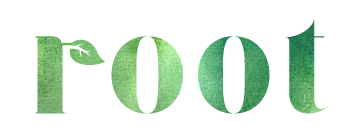













 moist grass, slowly raised my feet into the air (with bent knees first) and then straightened my knees – I did it! Navasana! This “win” didn’t occur overnight but bit-by-bit with steady moments of growth. It is my daily dedicated yoga practice – sometimes easy, sometimes hard – that made the difference. While there is still much room for improvement, I will celebrate progress and evolution as it occurs and find the treasures in the shaking abs, bent knees and everything in between.
moist grass, slowly raised my feet into the air (with bent knees first) and then straightened my knees – I did it! Navasana! This “win” didn’t occur overnight but bit-by-bit with steady moments of growth. It is my daily dedicated yoga practice – sometimes easy, sometimes hard – that made the difference. While there is still much room for improvement, I will celebrate progress and evolution as it occurs and find the treasures in the shaking abs, bent knees and everything in between.






Recent Comments